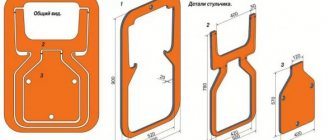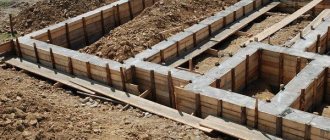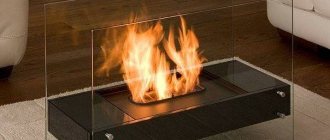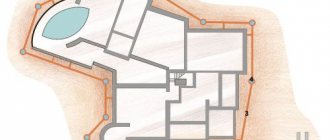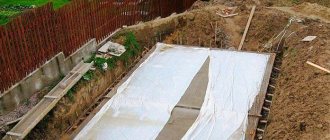If you follow construction standards and follow the sequence of technological processes, then the work can be done on your own and with minimal costs for building materials.
We will tell you in the article how and from what materials to make formwork for a strip foundation with your own hands.
What role does design play?
This is a special structure installed around the perimeter of the trench , which serves as a form for the concrete base and helps to achieve the exact dimensions of the foundation.
When pouring the solution, its walls are subjected to significant loads, so special requirements are placed on their strength. The geometric shape of the formwork must fully correspond to the dimensions of the monolithic base and have precise angles.
It is important for the builder to ensure that there are no cracks or gaps in the walls being erected. Even small holes will expand under intense load and the mixture will begin to flow out. Thus, voids are formed in the foundation mass, which reduce its performance characteristics.
Kinds
Traditionally, two types of construction are used - non-removable and collapsible .
In the first case, the formwork remains with the foundation after the mortar hardens. Builders save time and labor by eliminating the need for dismantling.
Collapsible formwork is more economical . Its design consists of individual elements that can be reused after the concrete has hardened.
This construction option takes more time and requires special attention from the craftsman to the tightness of the seams. Collapsible devices are convenient when working with complex foundations, as well as when constructing individual elements of structures.
Installation of universal ties
Before installing the universal ties into the XPS sheet, you must attach the reinforcement clamps to them. The location where the fastener is installed will determine the thickness of the protective layer of concrete - it varies in the range from 30 to 70 mm.
The slab is pierced with a rod, and a universal screed is placed in the resulting hole. Make sure that the fixture clamps are facing upwards. On the outside of the formwork, the universal screed is secured using a special lock - you just need to put it on the rod and then press it down until it stops.
The corner elements of permanent formwork are assembled using a universal screed and screw fasteners.
An energy-efficient solution involves installing thermal insulation in two layers. It is important to ensure that there is a 400 mm spacing between the layers.
What can it be made from?
It is easier for a builder to use ready-made collapsible formwork, but it is much cheaper to make it yourself from scrap materials. Racks can be made of the following materials:
- Tree. The most affordable option for self-construction. Wooden panels have such advantages as aesthetics and reliability. They are well processed and fastened using ordinary tools.
- Metal. Sheets made of carbide metal are characterized by strength, help to achieve an equal concrete surface and further strengthen the foundation.
- Plastic. Panels made of polypropylene are used as collapsible formwork elements. This material is lightweight and easy to use.
- Available materials . You can use slate or corrugated sheets that were left over from previous construction projects. But it will be difficult for the worker to achieve accurate geometry and there remains a risk of the solution leaking through the cracks.
For non-removable you can use:
- metal;
- reinforced concrete blocks;
- plywood;
- wood concrete;
- DSP;
- profiled sheet;
- expanded polystyrene;
- glass magnesite.
Which board should I use?
Experts recommend using cheap boards as the main material for formwork for work without the involvement of a construction team. This is an affordable building material that is not difficult to work with without having special equipment at hand.
However, the builder needs to take into account the requirements for wooden panels:
the type of wood is selected taking into account the humidity, which should be at least 22% (for example, conifers);- recommended board sizes: width – 15 cm, thickness – from 4 to 5 cm;
- the permissible size of the cracks is up to 2 mm (it is permissible to moisten the boards before pouring to swell and reduce the cracks);
- the wood surface must be free of any defects (knots, breaks);
- At least one side of the board should be smooth and have clean edges.
Compliance of the characteristics of the source material with the given recommendations guarantees that the boards will be able to withstand at least 15 pouring cycles if the technology is followed. Collapsible formwork elements made of chipboard, fiberboard and plywood can be used up to 30 times.
Advance paynemt
It is not difficult to independently calculate the required number of boards . It is more convenient to have a prepared drawing with exact dimensions. Calculations are carried out for each side of the formwork separately, and then added together.
To calculate the number of units of building material on one side horizontally, you need to divide the length of the tape by the length of the board. To calculate the amount of material in height, you need to divide the depth of the foundation by the width of the board.
At this stage, the builder needs to take into account that the panels should be slightly higher than the depth of the foundation, so the resulting value is rounded up.
The results of the two calculations are multiplied and the answer reflects the required amount of building material on one side of the foundation. Experts recommend having a supply of boards equal to approximately 10% of the calculated data.
To simplify calculations, you can use online calculators at construction services.
Choosing insulation
In this case, standard requirements are imposed on XPS: low water absorption, high heat-saving properties, resistance to aggressive environments, strength and dimensional stability. When choosing a material, it is very important to carefully study the information about the product, as well as visually inspect the slab. For example, the surface of the L-shaped edge of XPS TECHNONICOL CARBON ECO is smooth, without pronounced pores and voids. This indicates that the material does not absorb moisture, which means that in difficult conditions of constant contact with water and water-saturated soils it will retain its properties.
The permanent formwork is assembled immediately after the completion of preparatory excavation work. The preparation of the pit is necessarily preceded by an assessment of the condition of the soil, calculation of the bearing capacity, height difference, and marking of the axes of the house.
Auxiliary materials and working tools
To build formwork with your own hands, the builder will need:
- fasteners (nails, screws);
- beams for assembly and selections;
- waterproofing film;
- working tools (level, saw, axe, hammer, chisel and others).
The purchase of auxiliary materials for the builder will cost approximately 40-50% of the cost of the boards.
Technology
The entire technological process consists of several stages:
- Preparation of tools and materials.
- Making trenches under the tape.
- Cutting plywood.
- Development of a foundation diagram and carrying out some calculations.
- Connection of shields. The boards need to be cut into equal pieces and attached using nails or self-tapping screws. Any deviations from the specified geometry must be excluded.
- Fastening shields. The connection method is determined by the type of foundation. The removable version can be twisted from the outside, the non-removable version can be twisted using any convenient method.
- Installation of spacers. They use wooden blocks or pieces of plastic pipe.
To speed up excavation work, it is recommended to use special equipment. The technology itself remains simple and clear, so you can do the work yourself.
Manufacturing and installation
The whole process can be divided into several key stages:
- Preparatory – calculations and purchase of building materials.
- Transition to field work - marking the site and digging a trench according to the specified parameters.
- Production of blanks for panels (if it is not stamped material for formwork).
- Driving support beams into the ground.
- Installation of dampers.
- Strengthening.
Shield assembly
The size of the dampers is chosen taking into account the geometric shape of the base so that their height is greater than the depth of the concrete pad. The length of the elements is chosen arbitrarily, but the optimal value is considered to be no more than 3 m. The total length of the dampers must correspond to the length of the tape.
Shields can be a prefabricated structure made of boards. Fixing bars are attached across the boards in increments of 50-80 cm. The central and outer bars can be longer than the height of the formwork and have pointed ends that will go into the ground.
Installation Features
The finished dampers are installed according to the markings strictly in a vertical plane.
For convenience, you can drive in vertical beams along the perimeter of the base in advance and align the walls of the formwork closely to them. The worker must ensure that the elements fit tightly so that concrete does not flow out through the cracks . Armed with a level and a hammer, he needs to align all the shields exactly in the same plane and at the same height.
If the shields do not have long bars that could go into the ground and hold the structure, then vertical bars are first placed along the perimeter of the trench. These elements will serve as support for the shields, which must be tightly attached to them using spacers and slopes.
Strengthening
The walls of the formwork are subjected to heavy loads during concrete pouring and may fall apart. To prevent this from happening, additional elements are installed to strengthen the structure.
From the outside, the walls are supported by braces and supports . They are placed in increments of no less than 1 m. Particular attention is paid to the corners of the formwork, where support is needed on both sides at once. If the height of the shields is more than 2 m, then the supports are placed around the perimeter in two rows: upper and lower.
How to assemble and install dampers from various materials?
Previously, the general algorithm for installing formwork was considered. The use of different materials for shields requires its own installation features. It is easier for a builder who does not have special equipment to build a structure from boards, plywood or polystyrene foam.
Installation of boards from boards
This option is considered one of the easiest to install and the cheapest in terms of cost . When working with boards, a craftsman can make do with ordinary woodworking tools.
When there are cracks on the surface of the source material, leakage of the solution can be prevented using a plastic film that is attached inside the system.
Ordinary boards are a popular building material for formwork and even a beginner can cope with their installation. The only drawback is the need to strengthen the structure with additional elements (ties, supports, metal pins).
Made from polystyrene foam
Expanded polystyrene is a practical and high-quality material . Ready stamped blocks serve as shields. They quickly assemble into a single structure. The elements fit into grooves and are secured with threaded ties.
Difficulties may arise at the stage of selecting sheets of expanded polystyrene, when arranging the necessary corners and curves. Before pouring the concrete mixture, a reinforced frame can be placed in the formwork. A significant drawback is the high cost of polystyrene foam.
How to install plywood correctly?
Sheets of plywood will serve as reliable walls for the formwork . The assembly of elements is not much different from the standard scheme. The master’s task is to assemble a structure that accurately replicates the geometry of the base.
To maintain the accuracy of the width of the tape along the entire perimeter, identical bars are attached between the sheets of plywood. When working with a massive foundation, experts recommend strengthening the walls with screeds.
Accessories
Support posts for the installation of monolithic floors.
Element for constructing formwork wall systems and columns.
Element for fastening panels. Complete with nuts and washers.
Element for screeding panel formwork.
Panel connection element. We offer wedge, universal, extended and spring locks.
Supporting element for the installation of floors.
Locking mechanism for installing telescopic stands.
Equipment for setting up an outdoor working area.
Used for making straight corner connections for panels.
How to save money?
Laying the foundation with your own hands, in most cases, is explained by the desire of the master to save money on hiring a construction team. Therefore, it is advisable to consider additional ways to save.
Filling in layers
The use of removable formwork allows builders to reduce the cost of purchasing materials. The method involves the gradual pouring of concrete mixture .
After the solution hardens, the structure is dismantled and reassembled on another section of the tape. During the warm season, approximately 3-4 days pass between filling cycles.
Vertical division
The concreting process can be divided into stages both according to the length of the foundation and its height . When the bottom layer of the mortar has completely hardened, the cement laitance must be removed from its surface and you can begin the next cycle of formwork construction.
To make the building material last longer, the surface of the dampers can be covered with plastic film or treated with an aqueous solution of slaked lime.
The procedure for reinforcing a strip foundation
The existing scheme for reinforcing a strip foundation for building a house requires following several mandatory rules:
- Application when carrying out reinforcement of rods of class A400
- Minimizing the use of welding when connecting rods, as this technology helps to weaken the sections
- At the corners, the frame can only be tied; the use of welding at the corners is not recommended
- The protective layer of concrete used in a particular situation must be at least 4 centimeters to protect metal elements from the negative effects of the environment and corrosion
- The use of smooth reinforcement is not recommended
- During laying, concrete must not be able to get stuck between the rods, which will eliminate control over failure due to too frequent placement of metal rods
Detailed step-by-step instructions with photos and videos provided for clarity will help you create a reinforcement frame. A significant advantage of reinforced strip foundations is the combination of high reliability and affordable cost. Steel and concrete are high-strength materials.
This is important for creating a foundation for construction on any soil, except for naturally stable and reliable rocks. In other situations, reinforcement of any foundation will eliminate damage caused by stress
How is it formed
When carrying out work such as reinforcing a strip foundation, the drawings include three groups of rods:
- Working rods used for laying along the belt
- Horizontal elements arranged transversely
- Vertical options, transverse
The task of transverse reinforcement is to connect all working elements into a single unit of reliable, innovative working rods that is stable in use. They are often called clamps.
An important feature of the work is the use of SNP and other regulatory specialized documents for activities such as reinforcement of strip foundations. When calculating, SNiP 52-01-2203 is used
In this regulatory document it is easy to find all the necessary calculations for creating reinforcement for the strip foundation of a small country house.
What requirements for concrete are determined by regulatory documents?
If you follow the order of creating reinforcement, it is important to comply with the mandatory requirements for the concrete used in a particular work. When creating a strip foundation with your own hands at the site of future construction, it is worth considering that the main characteristics of the strength of concrete structures include resistance to axial compression, readiness to withstand tension and not respond to transverse fracture
Reliability correction factors can vary from 1 to 1.5
When creating a strip foundation with your own hands at the site of future construction, it is worth considering that the main characteristics of the strength of concrete structures include resistance to axial compression, readiness to withstand tension and not respond to transverse fracture. Reliability correction factors can vary from 1 to 1.5.
Turnkey price
To evaluate the benefits of self-construction, the master should have an idea of the average market cost of the service in Russia:
| City | Cost of laying 1 m3 of formwork |
| Moscow | 1000-1200 |
| Saint Petersburg | 1000-1200 |
| Ekaterinburg | 600-1100 |
| Novosibirsk | 600-900 |
| Nizhny Novgorod | 500-800 |
How to further strengthen it?
When it is necessary to pour a large amount of concrete mixture, the system is reinforced with metal pins.
Sometimes the walls of the formwork can split apart under the weight of the solution. In this case, it is advisable to install screeds along the top of the structure .
To fix the shields, the walls are supported with beams in one or two rows, depending on the depth of the concrete base. The foundation will be stronger if wooden pegs or reinforcing rods are driven into the ground around the entire perimeter at intervals of at least 0.4 m.
When to shoot, after how many days?
Dismantling of the structure is possible only after the solution has completely turned into a solid mass . The duration of the process is determined by the massiveness of the foundation, its depth, the grade of concrete, and the ambient temperature.
Under suitable weather conditions, foundations for heavy structures require up to 4 weeks to fully cure. For private housing construction, demoulding can be done after 20 days.
After dismantling, gaps may remain on the surface of the base. These defects are filled with soil or filled with cement mortar.
Dismantling of formwork
It is necessary for at least a week to pass before dismantling the structure can begin. All work is done in the reverse order, first all fasteners, ties and clamps are removed, and at the final stage the shields are dismantled. If the boards have been processed or a film has been laid, the walls will easily and quickly separate from the foundation.
In other cases, you will need to lightly tap the boards until the walls come away from the concrete. Today you learned how to make formwork for a strip foundation, now you can get to work, good luck!
